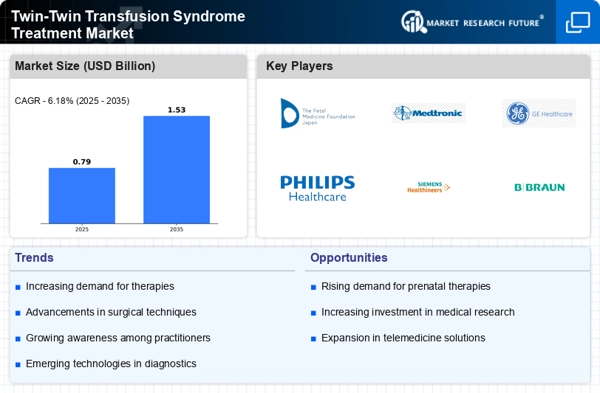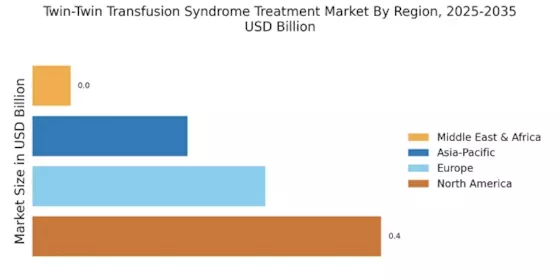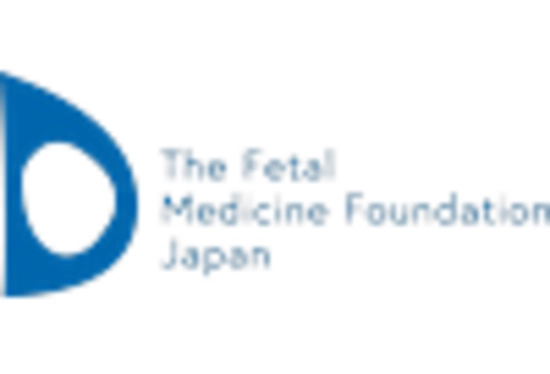Advancements in Medical Technology
Technological advancements in medical treatments and interventions are significantly influencing the Twin-Twin Transfusion Syndrome Treatment Market. Innovations such as laser photocoagulation techniques and minimally invasive surgical procedures have improved treatment outcomes for TTTS. These advancements not only enhance the efficacy of interventions but also reduce the risks associated with traditional surgical methods. The introduction of advanced imaging technologies, such as 3D ultrasound, allows for better diagnosis and monitoring of TTTS, facilitating timely interventions. As these technologies continue to evolve, they are expected to drive the demand for specialized treatment options within the Twin-Twin Transfusion Syndrome Treatment Market, ultimately improving patient outcomes and satisfaction.
Patient Advocacy and Support Groups
The emergence of patient advocacy and support groups is playing a pivotal role in shaping the Twin-Twin Transfusion Syndrome Treatment Market. These organizations provide essential resources and support for families affected by TTTS, raising awareness and promoting education about the condition. By sharing personal experiences and information, these groups empower patients and families to seek timely medical intervention. Furthermore, advocacy efforts often lead to increased funding for research and improved treatment options. As these groups continue to grow in influence, they are likely to drive demand for effective treatments within the Twin-Twin Transfusion Syndrome Treatment Market, ultimately benefiting patients and healthcare providers alike.
Increased Research Funding and Collaboration
The surge in research funding and collaborative initiatives among medical institutions is a critical driver for the Twin-Twin Transfusion Syndrome Treatment Market. Increased investment in research has led to a deeper understanding of TTTS and the development of novel treatment protocols. Collaborative efforts between universities, hospitals, and pharmaceutical companies are fostering innovation in therapeutic approaches, which may lead to more effective treatments. For instance, clinical trials exploring new pharmacological agents and surgical techniques are gaining traction, potentially expanding the treatment landscape for TTTS. This collaborative environment is likely to enhance the Twin-Twin Transfusion Syndrome Treatment Market by introducing new therapies and improving existing ones.
Growing Awareness Among Healthcare Professionals
The growing awareness of Twin-Twin Transfusion Syndrome among healthcare professionals is a significant driver for the Twin-Twin Transfusion Syndrome Treatment Market. As medical education programs increasingly incorporate information about TTTS, healthcare providers are better equipped to recognize and manage this condition. This heightened awareness leads to earlier diagnosis and intervention, which are crucial for improving outcomes for affected twins. Additionally, professional organizations are actively promoting guidelines and best practices for the management of TTTS, further enhancing the knowledge base within the medical community. As healthcare professionals become more informed, the demand for specialized treatments and interventions in the Twin-Twin Transfusion Syndrome Treatment Market is expected to rise.
Rising Incidence of Twin-Twin Transfusion Syndrome
The increasing incidence of Twin-Twin Transfusion Syndrome (TTTS) is a notable driver for the Twin-Twin Transfusion Syndrome Treatment Market. Recent studies indicate that TTTS occurs in approximately 10-15% of monochorionic twin pregnancies. This rising prevalence necessitates enhanced treatment options and interventions, thereby propelling market growth. As awareness of TTTS expands among healthcare professionals and expectant parents, the demand for effective treatment solutions is likely to surge. Furthermore, the growing number of assisted reproductive technologies, which often result in multiple pregnancies, may contribute to the higher incidence of TTTS. Consequently, the Twin-Twin Transfusion Syndrome Treatment Market is poised to experience significant growth as healthcare providers seek to address the needs of affected families.


















Leave a Comment